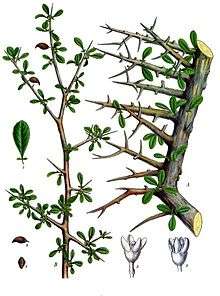Commiphora myrrha
| Commiphora myrrha | |
|---|---|
 | |
| Commiphora myrrha | |
| Scientific classification | |
| Kingdom: | Plantae |
| (unranked): | Angiosperms |
| (unranked): | Eudicots |
| (unranked): | Rosids |
| Order: | Sapindales |
| Family: | Burseraceae |
| Genus: | Commiphora |
| Species: | C. myrrha |
| Binomial name | |
| Commiphora myrrha (Nees) Engl.[1] | |
| Synonyms[2] | |
|
List
| |

Myrrh, the hardened resin extracted from Commiphora myrrha
Commiphora myrrha, called myrrh,[1] African myrrh,[1] herabol myrrh,[1] Somali myrrhor,[1] Common myrrh, or gum myrrh is a tree in the Burseraceae family. It is one of the primary trees used in the production of myrrh, a resin made from dried tree sap. The tree is native to the Arabian peninsula (Oman, Yemen) and to Africa (Djibouti, Ethiopia, Somalia, Northeast Kenya).[3]
Growth
Commiphora myrrha is very spiny and it grows to a height of about 4 m (13 ft). It grows at an altitude of between about 250 to 1,300 m (820 to 4,270 ft) with a yearly mean rainfall of about 23 to 30 cm (9.1 to 11.8 in). It does best in thin soil, primarily in areas with limestone.[4]
References
- 1 2 3 4 5 "Commiphora myrrha information from NPGS/GRIN". www.ars-grin.gov. Retrieved 2009-01-15.
- ↑ "The Plant List: A Working List of All Plant Species". Retrieved June 6, 2014.
- ↑ "Commiphora myrrha". www.cactus-art.biz. Retrieved 2009-01-15.
- ↑ "Species Information". www.worldagroforestrycentre.org. Retrieved 2009-01-15.
External links
This article is issued from Wikipedia - version of the Monday, August 31, 2015. The text is available under the Creative Commons Attribution/Share Alike but additional terms may apply for the media files.